1. The following results obtained in an experiment to determine the amount of water in a sample.
Mass of evaporating dish =25g.
Mass of evaporating dish + soil =50g
Mass of evaporating ++soil after heating =45g.
The percentage of water in the soil sample was
A. 20%
B. 55%
C. 79%
D. 80%.
2. Which one of the following functions is performed by only a modified leaf?
A. Food manufacture.
B. Gaseous exchange.
C. Transport.
D. Vegetative propagation.
3. Which one of the following is a method of preserving tap worm infection?
A. Wearing shoes.
B. Proper disposal of faces.
C. Treating infected individuals
D. Boiling drinking water.
4. Which one of the following is an effect of deforestation?
A. More oxygen accumulates in the atmosphere.
B. More plant nutrients are retained in the soil.
C. Formation of soil occurs rapidly.
D. More carbon dioxide accumulates in the atmosphere.
5. A plant with red flowers was crossed with another with white flowers and produced plants with only pink flowers. If the flowered plants were selfied and produced 60plants, how many of many of them would be expected to bear pink flowers?
A. 30
B. 10.
C. 40
D. 20.
6. Which one of the following is not a function of the jelly coat around the of a load?
A. Protecting the eggs from attacks by fungi and bacteria.
B. Keeping the eggs together.
C. Providing nourishment to the developing embryo.
D. Protecting eggs from drying up
7. Which one of the following equations represents anaerobic respiration in plants?
A. Glucose →carbon dioxide and water.
B. Glucose → carbon dioxide + alcohol + energy.
C. Glucose → water + alcohol + energy.
D. Glucose → carbon dioxide + energy
8. Which one of the following is a correct difference between sensory and motor neutrons?
|
Motor neurons |
Sensory neurons. |
|
A. Carry impulses from receptors to central nervous system. |
Carry impulses from central nervous system to effectors |
|
B. Cell body on the side of the axon. |
Cell body at the end of the axon.
|
|
C. Has long axon |
Has short axon. |
|
D. Cell body in the central nervous system |
Cell body outside central nervous system. |
9.The aim of experiment set –up in figure 1 is to demonstrate that
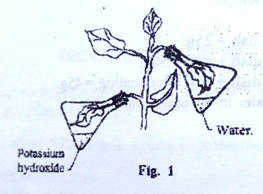
A. Oxygen is produced during photosynthesis.
B. Chlorophyll is necessary for photosynthesis.
C. Carbon dioxide is necessary for photosynthesis
D. Light is necessary for photosynthesis.
10.Which one of the following is a difference between an adult and newly hatched nymph of a cockroach?
Adult Nymph
A. Has three pairs of legs Has no legs.
B. Has a compound eye. Have no eyes.
C. Has wing Has no wings
D. Has a pair of antennae Has no antennae.
11. Which one of the following is a taxonomic class?
A. Annelida.
B. Arthropoda.
C. Arachinida
D. Platyelminuthes.
12. When testing for non-reducing sugar in a solution, hydrochloric acid is added to the solution in order to
Provide a suitable PH.
A. Kill any bacteria in the solution.
B. Hydrolyse the non-reducing sugar.
C. Catalyse the reaction.
13.. Which one of the following represents the correct sequence of stages in cell division, after interphase?
A. Metaphase, anaphase, prophase and telophase.
B. Prophase, metaphase, telophase and prophase.
C. Anaphase , metaphase, telophase and prophase
D. Telophase , anaphase, metaphase and prophase
14. Which of the following features describes the thoracic vertebra?
A. Short neural spine and long transverse processes.
B. Long neural spine and short transverse processes.
C. Short neural spine and short transverse processes
D. Long neural spine and long transverse processes
15. The following activities are result of transpiration in a plant except
A. Absorption of mineral salt from the soil, by the plant.
B. Movement of water up the plants stem.
C. Absorption of water from the soil, by the plant.
D. Cooling of the plant.
16. An individual deficient in anti –diuretic hormone is likely to produce
A. Vast quantities of dilute urine.
B. Urine containing glucose
C. Little concentration urine.
D. Urine containing proteins.
17. Figure 2 is a simplified representation of the nitrogen cycle
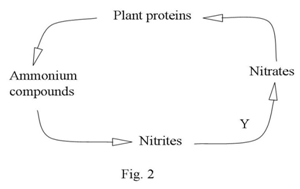
Which one of the following types of bacteria are responsible for the change along Y?
A. Nitrogen fixing bacteria.
B. Denitrifying bacteria.
C. Putrefying bacteria.
D. Nitrifying bacteria.
18. The following is a dichotomous key.
1 a Has wings……………2
b Has no wings…………3
2 a Has long antennae……X
b Has short antennae……W
3 a Has two main body parts Y
b Has three main body parts Z
Which one of the following represents a tick?
A. Z
B. X
C. W
D. Y.
19. Which one of the following types of feathers is correctly matched with its main function?
Type of feather Function
A. Quill protection
B. Filo plume Sensory
C. Convert Insulation.
D. Down Flight
20. The following are advantages of vegetative reproduction except
A. Off spring are resistant to diseases.
B. Off spring grow faster.
C. Off spring obtain food from parent.
D. Good characteristics of the parent plant are preserved.
21.Which one of the following is correct about the circulation of blood to and from The mammalian heart?
A. Oxygen blood from lungs heart through the pulmonary artery.
B. Deoxygenated blood from heart enters lungs through the pulmonary artery.
C. Oxygenated blood from heart goes to rest of the body through the vein cava
D. Deoxygenated blood from body enters heart through pulmonary vein.
22. During gaseous exchange in fish, oxygen diffuses into blood through the
A. Operculum
B. gill rakers
C. gill filaments.
D. Gill bar.
23. The role of the luteinizing hormone is to
A. cause ovulation
B. Thicken the uterine well.
C. cause development of the Graafian follicle
D. maintain pregnancy
24. Figure 3 represents types of leaves
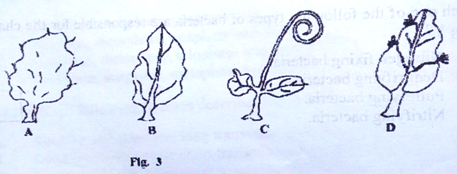
Which one of them does not represent a modified leaf?
25. An experiment was set up as in figure 4 and left to stand for sometime.
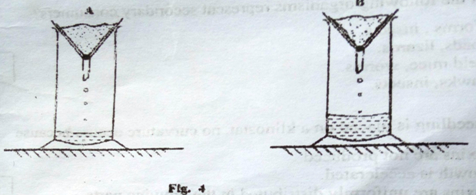
The properties of soil that were being investigated were
A. water capillaries and amount of humus
B. Amount of air and humus in the soil.
C. Soil particles size and air in the soil.
D. Water drainage and retention of the soli.
26. Which one of the following is a function of integuments after fertilization?
A. Storage of food for the embryo.
B. Provision of support to the seed.
C. Protection of the inner parts of the seed.
D. Allowing air into the seed.
27. Which one of the following is true of aerobic respiration in animals?
A. Produces more energy than anaerobic respiration.
B. Incomplete oxidation of glucose occurs.
C. produces lactic acid
D. Does not require oxygen.
28. Figure 5 represents a food web in a habitat
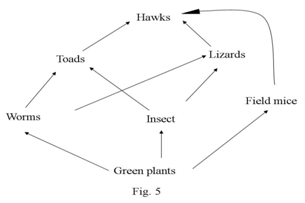
Which of the following organism represent secondary consumers?
A. Worms ,insect
B. Toads , lizards
C. Field ice, worms.
D. Hawks, insect
29. When a seedling is placed on a klinostat, no curvature occurs because.
A. Auxins are not produced.
B. Growth is accelerated
C. Auxins are uniformly distributed in the growing parts.
D. All parts of the seedling are uniformly lit.
30. Digestion of proteins in mammals starts in the
A. Stomach.
B. Mouth.
C. Duodenum.
D. ileum
31. An experiment was carried out to investigate the effect of sodium chloride solution an red blood cells. The red blood cells were placed in sodium chloride solutions of different concentrations and some red blood cells burst in the solution. The percentage of cells which burst in each solution was determined and results were recorded as in table 1
|
Sodium chloride concentration (g/100cm3) |
Percentage of red blood cells which burst |
| 0.33 0.36 0.38 0.39 0.42 0.44 0.48 |
100 91 82 69 30 15 0 |
(a) Explain why red blood cells burs when placed in some solutions of sodium chloride
(b) In the space provide, plot a graph of percentage of red blood cells which burst, against the sodium chloride concentration.
(c) From your graph, determine the concentration of sodium chloride solution in which the cells were equal to the intact cells.
(d) Explain the results obtained at the following concentrations of the sodium chloride solutions.
(i) 0.33g/100cm2
(ii) 0.48g /100cm2
(e) Explain what would happen to the red blood cells if they were placed in a sodium chloride solution of 0.5g /100cm3
32. Figure 6 represents a transverse section of a leaf
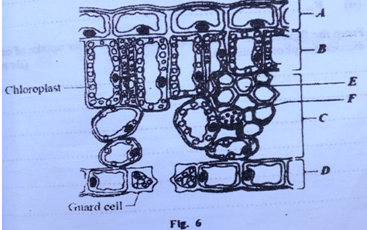
(a) Name the parts labeled A,B,C and D
A
B
C
D
(b) How are cells in layers A,B and C a adopted to perform their functions?
A
B
C
(c) Name the materials to materials to an sported by structures E and F
(i) E
(ii) F
(d) From the figure, state three adaptations of a leaf for uptake of carbon dioxide for Photosynth
33. (a) Explain how each of the following parts of the skin regulates body temperature when environmental temperature is low.
(i) Hairs
(ii) Sweat glands
(b) Give reasons why it is necessary to maintain body temperature.
34. Explain the role of each organism in the following associations
(a) Bacteria in root nodules of leguminous plants.
(b) Fungus and algae in the lichen.
35. (a) Describe how a bony fish is adapted for locomotion
(b). Describe how muscles cause flight in insect.
36. Describe the activities which
(i) Add carbon dioxide to the atmosphere.
(ii) Remove carbon dioxide from the atmosphere.
37. (a) Describe the activities of digestion which occur in each of the following parts of the alimentary canal.
(i) Stomach
(ii) Ileum.
(b) How is the ileum adapted to food to food absorption?
